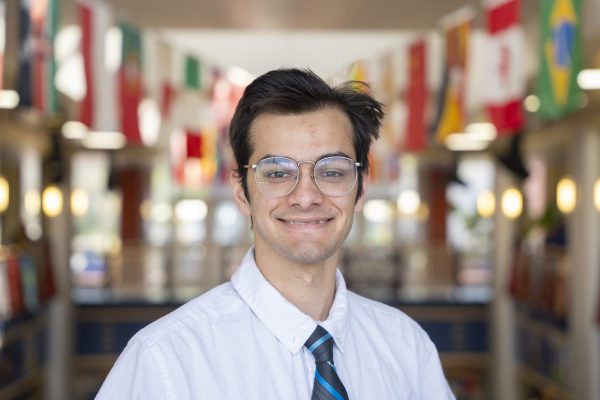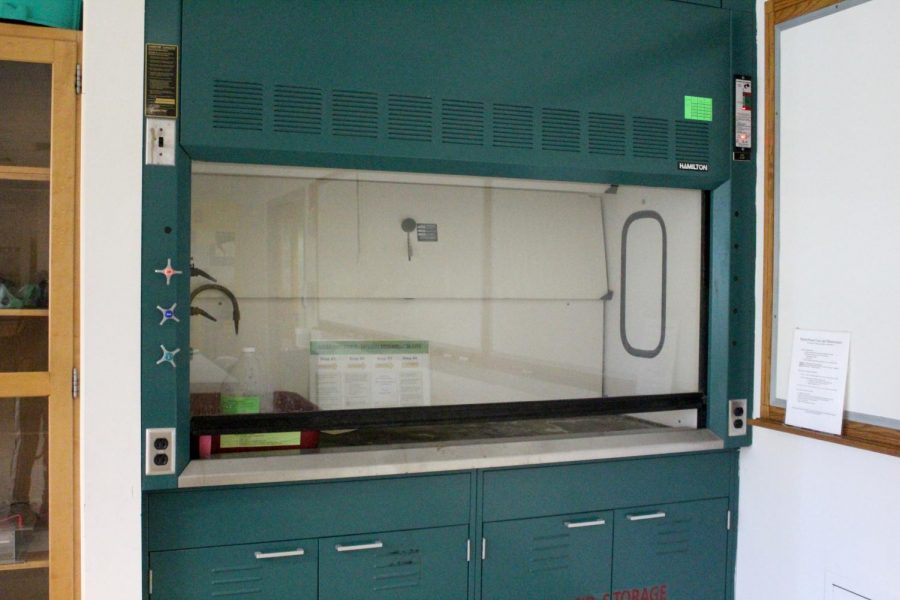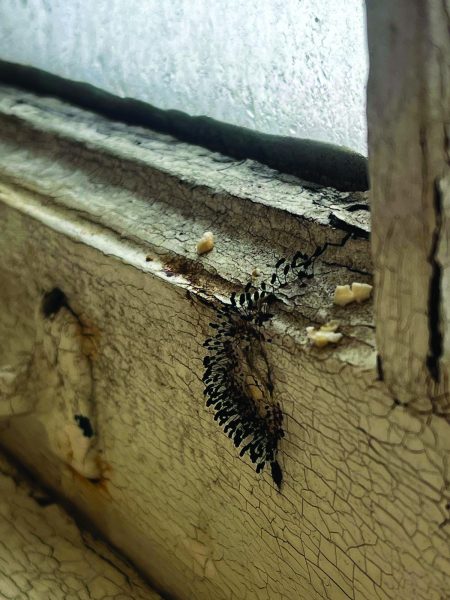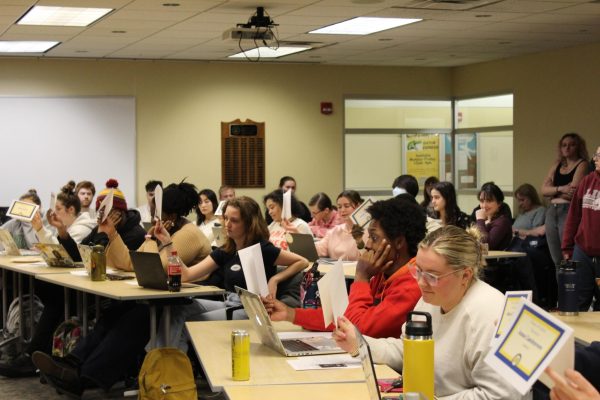Gone, but not forgotten: mask debate lingers
Professors divided on masking in classrooms as classes begin for fall
“Fume hoods” like this one in the Doane Hall of Chemistry helped some of Professor Tim Chapp’s class meet at almost full capacity before the vaccine became widely available.
Allegheny College fully returned to in-person instruction on Aug. 24 for the first time since the COVID-19 pandemic forced students home in March of 2020. Most students have elected to attend class and walk around without a face covering, as the Allegheny College Health Agency has lifted almost all masking and physical distancing requirements put in place over the last year to combat COVID-19.
Assistant Professor of English and Director of the Education Studies program Susan Slote said that the overall sense she has gotten from the return to campus has been positive
“I’ve got a sense of tremendous joy for people to be back together again, and I’ve heard that from students and from other faculty colleagues,” Slote said. “I think there’s some caution about where COVID’s going, but certainly in terms of the experience of learning together, there was a lot of excitement in my groups.”
Some faculty members, like Tim Chapp, assistant professor of Chemistry, and Matthew Ferrence, associate professor and chair of the English department, are electing to mask because of family members who are not able to get vaccinated.
“My reason for wearing a mask is that my daughter is 10 and hasn’t been vaccinated yet,” Chapp said. “I just explained that to (my students), and they were all super understanding “
Ferrence, who is also masking for his children, feels a bit uncomfortable with the current atmosphere.
“I don’t blame students for not masking because they’re not obligated to do so, (but) it is disconcerting understanding the rise of the delta variant, particularly in Crawford County,” Ferrence said. “I don’t worry about it when I’m teaching, but when I think about it (it) does make me a little nervous.”
Allison Connell-Pensky, associate professor of psychology, thinks that the students are being “duped” into believing they can be unmasked and do not have to distance.
“I believe we’re essentially being gaslit by being told that (we can be unmasked),” Pensky said. “It is not safe. There is a multitude of published studies that show we need to continue to be masked. The CDC still says we should be masked. The American Academy of Pediatrics says we should be masked.”
CDC guidelines currently state that fully vaccinated individuals should mask “in areas of substantial or high transmission.” While Crawford County is among the areas of high transmission, the college itself has a positivity rate of around 0.072%, compared to the county’s positivity rate of 26%.
But Pensky does not draw a line between the college and the community.
“We can’t pretend that Allegheny College is a community wholly separate from Crawford County,” Pensky said.
However, the AAP guidelines are for communities with significant unvaccinated populations.
“AAP recommends universal masking because a significant portion of the student population is not yet eligible for vaccines, and masking is proven to reduce transmission of the virus and to protect those who are not vaccinated,” the AAP website states.
Chapp feels like the campus is fairly safe given the 99% student vaccination rate and 94% faculty vaccination rate.
“The campus itself feels to me like a pretty safe space, and the data so far suggests that even though there have been breakthrough cases, transmission from person-to-person seems lower,” Chapp said. “I wouldn’t be surprised if we went back to masking, but vaccines have been shown to be effective.”
Vaccines also meant Chapp’s summer research students were able to function at a pre-pandemic level, hitting what he called “critical mass” in terms of research efficiency. Even before the vaccine, in the spring semester, students in some of the chemistry labs were able to work pretty close to each other because of “fume hoods” — complex vents that prevent noxious fumes from building up in a lab setting.
“Whenever we’re in one of those labs, the fume hoods are always running, so the airflow turnover is similar to what it would be if you’re outside on a somewhat windy day, so students could be working a little bit closer than they might otherwise be if it was just a normal space,” Chapp said.
Other professors did not fare as well with masks and distancing, particularly with the hybrid model of having half the class attend virtually, and the other half in a physical classroom.
“With the fully remote model, I really could teach with that complete context in mind,” Slote said. “In the hybrid model, I couldn’t. We were doing a lot of stuff in (module one of the spring 2021 semester) that was directly connected to, ‘Well, how do we overcome this distance between us,’ and while I always have that in mind when I teach, in the hybrid model, you have to then have two different models in mind. I don’t miss that at all.”
Hybrid models of learning are brought about when students have to socially distance, but according to Patterson even masking can have a detrimental impact on the learning environment, as students miss facial cues and other subtle textures of communication.
“(Masking) does make teaching harder and less accessible,” Patterson said. “I would understand if we brought masks back, but I do think it would add another layer of difficulty to teaching and to learning.”
Pensky, like Ferrence and Patterson, thinks that whether or not an individual class requires masking should be up to the instructor.
“I would love for the college to require masks period, but at the very least to allow the faculty and the staff with offices in-person on campus the agency to protect their own health and to require masks when they’re in shared spaces with other community members,” Pensky said. “That would be a good first step.”
While Ferrence would strongly prefer that his entire class masks, he also recognized the potential divisiveness of having multiple different mask policies in the same building.
“I don’t like the dynamic across the community if it winds up being an antagonistic or adversarial relationship between the students and the faculty,” Ferrence said.
Ferrence also noted that the predominant social norm is to go unmasked, contrary to a poll conducted by The Campus in early August. That poll suggested that just over half of all students who responded would be masking upon returning to campus. But now, the vast majority are unmasked.
“There’s probably a lot of people that don’t care one way or another if they were wearing a mask or not, and those are people that understandably — and I don’t criticize them — won’t wear a mask if the messaging and social convention is to not (mask),” Ferrence said.
As of Sept. 1, the college had two active cases of COVID-19 according to surveillance testing conducted by the college. But Pensky does not trust those tests to be accurate.
“There is some benefit to … lower (positivity) rates on campus, according to our rapid antigen tests, which have some flaws in testing for COVID in vaccinated individuals,” Pensky said. “Let’s put that out there; these could be false negatives, as well as true negatives.”
On her first day of class, Pensky tried to convince her students to wear face coverings.
“I presented that evidence and I shared a box of masks for anyone who didn’t have one or just wanted a spare one,” Pensky said.
Pensky soon heard that a student expressed their concerns to the administration and Pensky later discussed the incident with Provost Ron Cole, ’87.
Cole declined to comment on specifics regarding the matter and instead issued the following statement to The Campus.
“Our mask policy, informed by ACHA recommendations, is based on the very high vaccination rate among students and employees, our protocol for COVID-19 testing, and the very low COVID-19 positivity rate on campus,” Cole wrote in the statement. “The professionals in ACHA review our COVID-19 policies regularly and these can change at any time based on changing conditions. I remind all students and employees that they are strongly encouraged to wear masks when in public indoor spaces off campus and that N-95 masks are available from ACHA for those that would like to wear one in classes. Anyone is welcome to wear a mask on campus and as a community of mutual care, I hope that we will all respect the health concerns of one another.”
But Pensky does not believe that the ACHA is being honest.
“I think the college’s current COVID response is motivated by finances and politics, but that we’re being told that it’s for our safety,” Pensky said. “The college is scared about the backlash from some students (and) families if it were to mandate masks, and the potential loss of tuition and fees from some students if they chose to withdraw because of a mask mandate.”

Sami Mirza is a senior from many different places. He is majoring in International Studies with a focus on the Middle East and North Africa and minor in...








